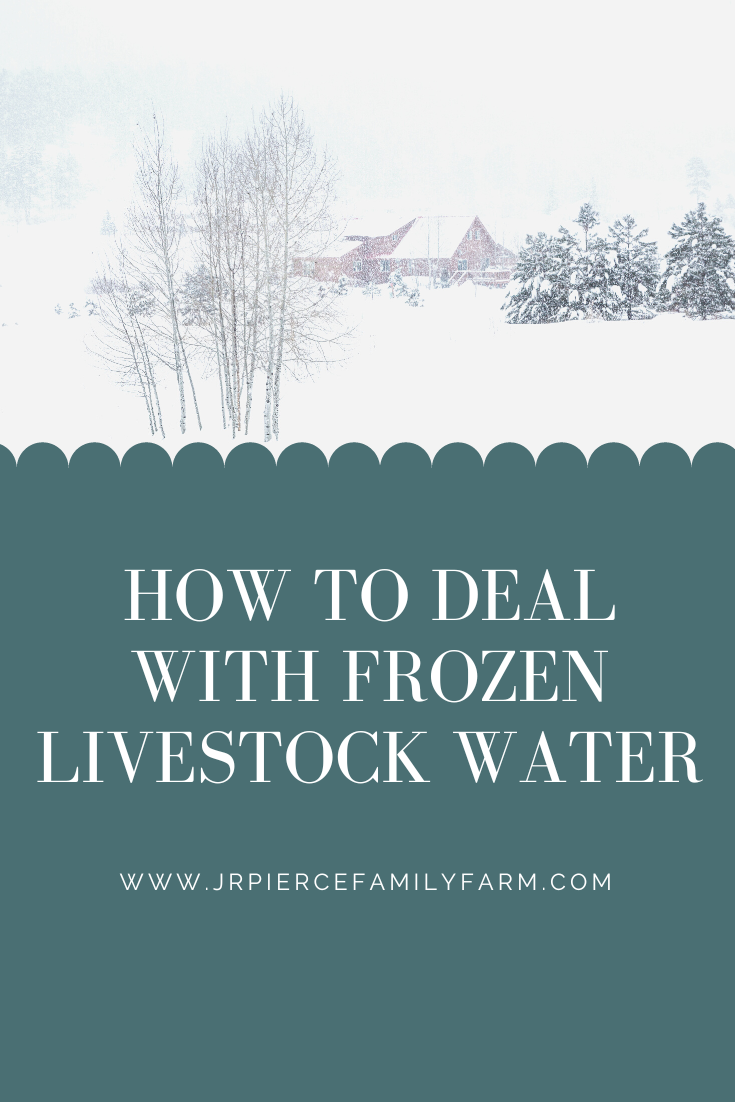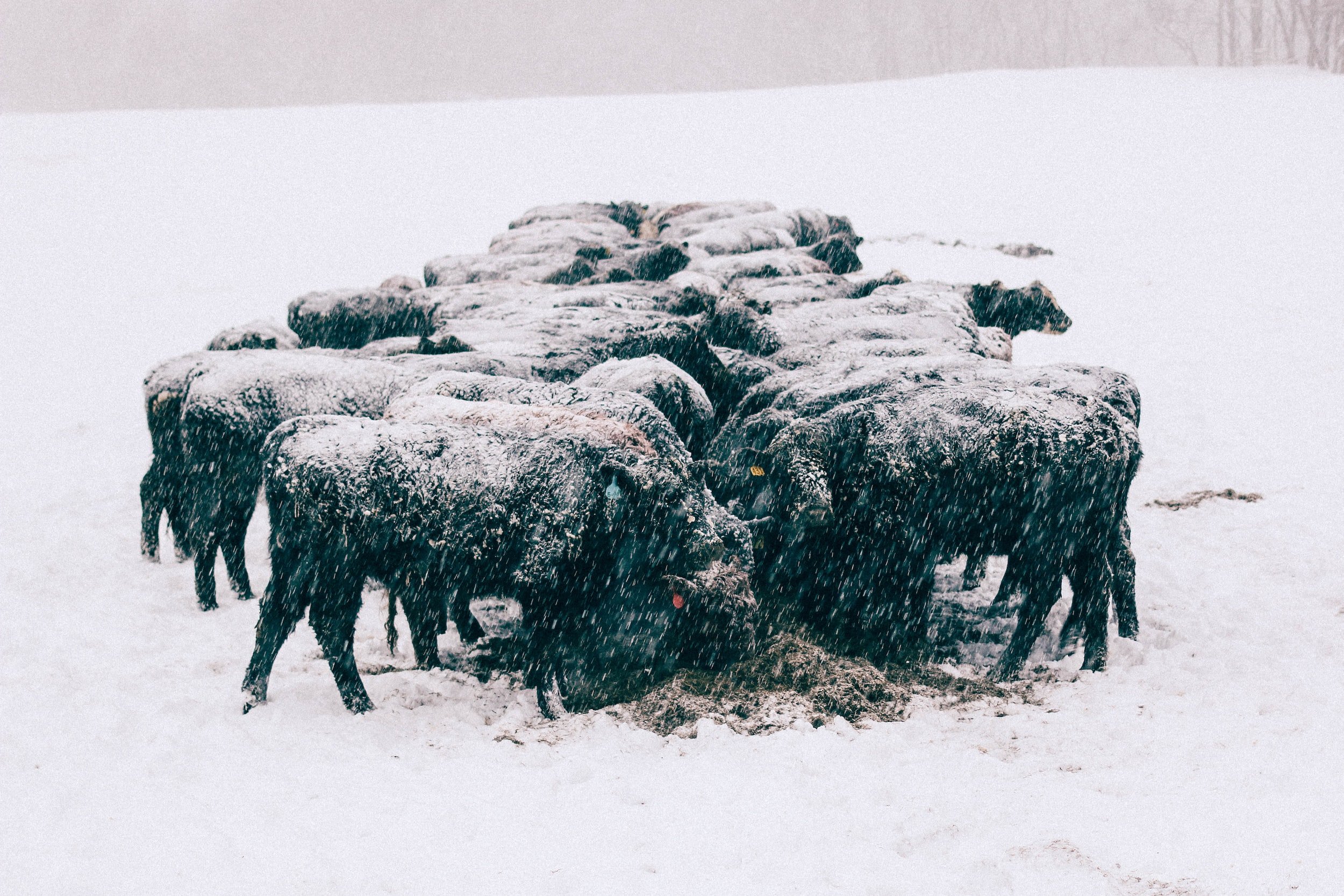14 Tips for Preventing Frozen Livestock Water This Winter
I feel like we just finished thawing out from all of last winter’s ice and snow, and guess what?
More snow this week. In fact, tonight, we’re anticipating about a foot of snow. Happy Veterans Day!
It seems as though each year, winter comes a bit earlier. We were grateful this year just to be able to finish our monumental hoop house project (the thing is 30x96 ft!) in time to get the chickens undercover before the freezing temperatures arrived.
Managing winter weather is a lot more difficult when you have animals to care for. They are pretty resilient little buggers, but the fact of the matter is that it’s really tough to prevent waterers from freezing when temperatures dip below 32 degrees.
And the reality is that where I live, those temperatures are sustained pretty much from November straight on through to April - and sometimes past that, too.
You have to get creative, that’s for sure!
Here are some tips on how to prevent animal waterers from freezing this winter.
**J&R Pierce Family Farm is a participant in the Amazon Services LLC Associates Program, an affiliate advertising program designed to allow sites to earn advertising fees by linking to products on Amazon. I often link to Amazon when recommending certain products, and if you choose to purchase, I may earn a small percentage of the sale. It costs you nothing extra, and all recommended products are ones that I personally vouch for. **
What to Put in Livestock Water to Keep it From Freezing?
Some good options to prevent your livestock water from freezing include:
Cow balls
Bucket insulators
Electric water heaters
Insulated plastic holders
Keep reading to learn more about how to prevent your animals’ waterers from freezing and check out the video below for even more tips:
14 Tips to Prevent Frozen Livestock Water
Frozen water can be a serious problem for livestock, as they need water to stay hydrated and to maintain their body temperature. If you live in an area with cold winters, it's important to take steps to prevent your animals' water from freezing. Here are 14 tips to help you keep your livestock's water thawed out all winter long:
Use Cow Balls
Not...you know...those kinds of balls.
Cow balls are large plastic balls that cover the surface of the water tank. The balls decrease the amount of the water’s surface area that is exposed to the cold temperatures, and when ice does happen to form, the cows can break through the ice by pushing down on the balls with their noses. Smart!
Create Movement
Water has a harder time freezing when there’s movement - that’s why those beautiful babbling brooks take longer to freeze than stagnant ponds. If your nighttime lows don’t get too awfully cold, you can use a pump or water circulator to create movement and help prevent the water from remaining still.
Insulated Plastic Holder
If your winter temperature don’t habitually dip below 15 degrees, you can get away with these insulated plastic bucket holders. Unfortunately, these aren’t really an option for us throughout much of the winter months. They work in a pretty simple manner, though - all you do is fasten the buckets to the wall and the top of the insulators have openings in which you can slip a plastic five-gallon bucket.
The holders are equipped with foam insulation so you don’t have to worry about the water freezing. Again, they don’t work as well when the temperatures dip below 15 degrees - but they’re a good option in the interim.
DIY Bucket Insulators
If you want to get really crafty, try this hack - you can make your own insulator by fitting an old tire around a bucket, filling the interior of the tire with rocks, and placing the bucket inside the tire. The theory behind this method is that the bucket and tire will absorb the heat of the sun all day, and that the rocks will help retain some of that warmth overnight. In theory, the bucket will remain thawed until morning.
I haven’t tried this hack, and while it seems as though it would work with minimal expense, it probably isn't the best for places like northern New York, where nighttime temperatures plummet pretty low.
Switch to Rubber
If you can, change out your watering system so that you are using rubber tubs instead of galvanized waterers. These don’t freeze up quite as easily (especially if they are black) and are much easier to break the ice out of when the water does freeze.
Use Strategic Placement
Now is not the time to keep your waterers outside for your animals - get them moved indoors to your barn or even just a location that is sheltered from the wind. This will reduce a lot of your chores.
If you have your waterer inside and out of the wind and frozen water is still a problem, consider placing multiple rubber watering tubs close together and placing insulation around them. This can help hold heat, too.
Use an Electric Water Heater or De-Icer
These are submersible and work quite well to prevent the waterers from freezing. We use them in our sheep trough and it’s a great solution, since the sheep have no interest in knocking over their water tubs.
They don’t work as well with pigs, since pigs have a tendency to want to play with their watering system. They also don’t prevent nipple waterers from freezing, so that’s something else to keep in mind.
One thing to keep in mind is that an electric heater won’t work if you, obviously, don’t have electricity! Or if you lose electricity in a power outage. However, you can often use a propane heater instead of an electric one - you will just need to make sure the pilot light doesn’t go out.
Use Heated Fount Bases
If you have chickens, a quick and easy way to prevent your waterers from freezing is to use plug-in heated waterers like this or heated bases like this one. These work with any galvanized poultry waterer and are simple to operate - just put them under your waterer, plug in, and go.
Get Salty
I’ve heard from many people living off-grid that a good hack for preventing waterers from freezing is to fill a milk jug halfway full of saltwater. It will take a long time for it to freeze and it will float. This allows your animals to push the jug down to break the ice when it inevitably forms.
Essentially, it’s a low-cost version of the cow balls I mentioned above. I haven’t tried it yet, but it seems pretty legit.
Install a Frost Free Trough
A lot of companies like Mirafount, Jug Waterers, and Richie manufacture so-called frost-free water troughs. These have to be installed exactly according to the manufacturer’s instructions, otherwise you run the risk of a frozen trough. You also need to bury pipes super deep (below the frost line) to protect them.
These are not inexpensive solutions and are only for serious operations only - but are good permanent solutions if you have a lot of animals to water.
Use a Heated Bucket
These heated buckets don’t work as well if you have a ton of animals, but they are a good solution if you only have a few.
Only Use High-Rated Extension Cords
If you must run an extension cord to your waterers, only use those that are heavy-duty and rated for outdoor use - and outdoor use in the winter time. You don’t want to run the risk of a fire!
Avoid Heat Lamps if Possible
A lot of people assume that heat lamps are the end-all-be-all when it comes to keeping animals and water warm in the winter. I strongly advise against the use of heat lamps - not only for the reasons I talk about in my article about preventing chicken coop fires here - but also because they don’t do a great job at keeping water thawed. Use one of the other methods instead.
Know That a Freeze is Inevitable
I hate to sound like a Debbie Downer, but in the winter, ice and cold are just two things you are going to have to deal with. Even automatic heated waterers will freeze up from time to time. There are ways to overcome this - you just need to be vigilant so that your animals don’t go more than a couple of hours without water.
If your automatic waterer freeze, simply release the plug, drain, and fill back up with warm water. You can also take a rubber mallet to knock around the lids or sides of the ball to release the ice.
The best thing you can do is to have a system in place if and when your waterers do freeze. By being prepared, you can reduce a lot of the stress that comes with winter farm management!
Why You Need to Prevent Livestock Waterers from Freezing
Animals can get dehydrated in the wintertime just as easily as they can in the summer. It might take a few more hours for it to happen, but sure enough, it can happen. A dehydrated animal is not a healthy animal, and it doesn’t take long for other health problems to arise as a result.
This winter, instead of spending all of your time breaking up the water this winter, consider implementing some of the hacks I mentioned above! You’ll be able to spend less time trudging around in the snow...and more time warming up inside in front of the fire.
What other tips do you have for preventing frozen livestock waterers? Be sure to let me know in the comments!
Want to learn more about farming? Be sure to check out these featured articles!
Subscribe to our email newsletter for regular tips and tricks on homesteading and farming – wherever you are. You can also follow us on Instagram (@jrpiercefamilyfarm) and Pinterest (J&R Pierce Family Farm) for frequent updates. Happy homesteading!




